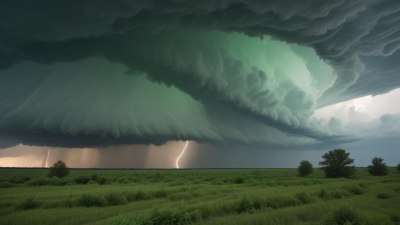Why You Can’t Meditate Properly if the Forecast Says “Unsettled”
Explore how weather affects meditation and mental clarity based on unsettled forecasts.

This image was created with the assistance of Freepik
Meditation is often seen as a sanctuary of peace amidst chaos, a way to connect with one's inner self and cultivate mindfulness. However, for many, the practice can be more challenging when external conditions, such as weather forecasts, hint at 'unsettled' atmospheric conditions. But what does an unsettled forecast mean, and how does it impact our ability to meditate effectively? In this article, we’ll delve into the intricacies of meditation and the surprising influence of weather on our mental state.
Understanding Unsettled Weather
Unsettled weather refers to conditions that can cause fluctuations in day-to-day meteorological parameters, such as temperature, humidity, and atmospheric pressure. When forecasters describe the weather as unsettled, they imply that there could be sudden changes, including storms, rain, or extreme temperatures. Physically, these changes can increase anxiety and affect our mood, creating a ripple effect on our ability to focus and meditate.
The Psychological Impact of Weather
The relationship between weather and mental health is well-documented. Studies have shown that gloomy, rainy days can lead to heightened feelings of sadness or lethargy, while sunny weather generally encourages a more positive mood. An unsettled forecast can stir uncertainty and anxiety, creating a mental backdrop that is less than conducive to meditation. When our minds are preoccupied with worries about upcoming storms or fluctuating temperatures, it becomes increasingly difficult to find that calm and centered state necessary for effective meditation.
Disruptions to Your Environment
Meditation typically requires a tranquil environment, free from disturbances. However, unsettled weather can lead to various disruptions—be it the sound of rain, thunder, or high winds rattling windows. These environmental factors can distract from the meditative process, making it harder to achieve the peaceful state that is so critical for meditation. In essence, if your surroundings are unpredictable or chaotic, your mind is likely to mirror that turbulence, further complicating your ability to meditate.
Physical Discomfort and Temperature Variability
When the weather is unsettled, temperature changes can be pronounced throughout the day. One moment can feel hot and humid, while the next can bring on a chilly breeze. This variability can lead to physical discomfort, which is a significant hindrance to meditation. It’s challenging to focus inward when your body is trying to adjust to rapidly changing external temperatures. For many, meditation requires a comfortable and stable physical environment; if the temperature is unpredictable, so too is our ability to settle into our practice.
Seasonal Affective Disorder and Meditation
For individuals who experience Seasonal Affective Disorder (SAD), the implications of unsettled weather can be especially pronounced. Unpredictable atmospheric conditions can lead to increased feelings of depression and lethargy, which can disrupt not only daily activities but also practices such as meditation. If one's mood is significantly impacted by seasonal changes, the practice of meditation may feel unattainable, as achieving focus and clarity requires a baseline of mental well-being.
Mindfulness Amidst Chaos
Despite the challenge that unsettled weather poses to meditation, it also offers an opportunity to practice mindfulness amidst chaos. Learning to meditate while dealing with external disturbances can be a valuable skill. It teaches resilience and adaptability, which are important qualities for not only meditation but life as a whole. In this way, unsettled weather can serve as a backdrop for growth, prompting practitioners to develop strategies to maintain focus—being aware of external noise while not letting it dominate their internal state.
Developing Strategies for Meditation During Unsettled Weather
Even during unsettled weather conditions, it is possible to cultivate a meaningful meditation practice with some adaptations. Here are a few strategies to enhance your ability to meditate effectively, even when the forecast is less than ideal:
1. Create a Cozy Space
Designate a specific area in your home that feels safe and comfortable, regardless of the weather outside. Surround yourself with soft pillows and blankets or use ambient lighting to create an inviting atmosphere. A cozy nook can offer comfort against the unpredictability of the weather.
2. Use Sound to Your Advantage
Consider using soothing sounds or music to mask external disturbances during meditation. White noise machines, nature sounds, or calming instrumental music can create a serene backdrop that helps you focus. This auditory layer can serve as a buffer against the chaotic sounds of unsettled weather outside.
3. Practice Breath Awareness
During unsettled weather, return to the fundamentals of meditation—your breath. Focus on your inhalations and exhalations, allowing yourself to anchor into this fundamental rhythm. When your body and mind feel chaotic, breath awareness can provide a point of stability.
4. Embrace Shorter Sessions
If full-length meditation sessions seem daunting during unsettled conditions, try shorter practices. Even just a few minutes of focused breathing or mindfulness can help recalibrate your mental state without feeling overwhelming.
5. Set Realistic Expectations
Finally, recognize that some days will be easier than others. Setting realistic expectations for your practice allows you to navigate through fluctuations in focus and clarity. On unsettled days, understand it may be more about presence than perfection.
Navigating Meditation in Uncertain Times
Ultimately, while unsettled weather may pose challenges to meditation, it can also serve as an invitation to deepen your practice in unexpected ways. By developing strategies to navigate these conditions, you cultivate resilience, allowing the disturbances outside to be an opportunity for growth rather than a setback. Embrace the uncertainty as part of the journey and remember that meditation is a flexible practice that adapts to our ever-changing environment.











